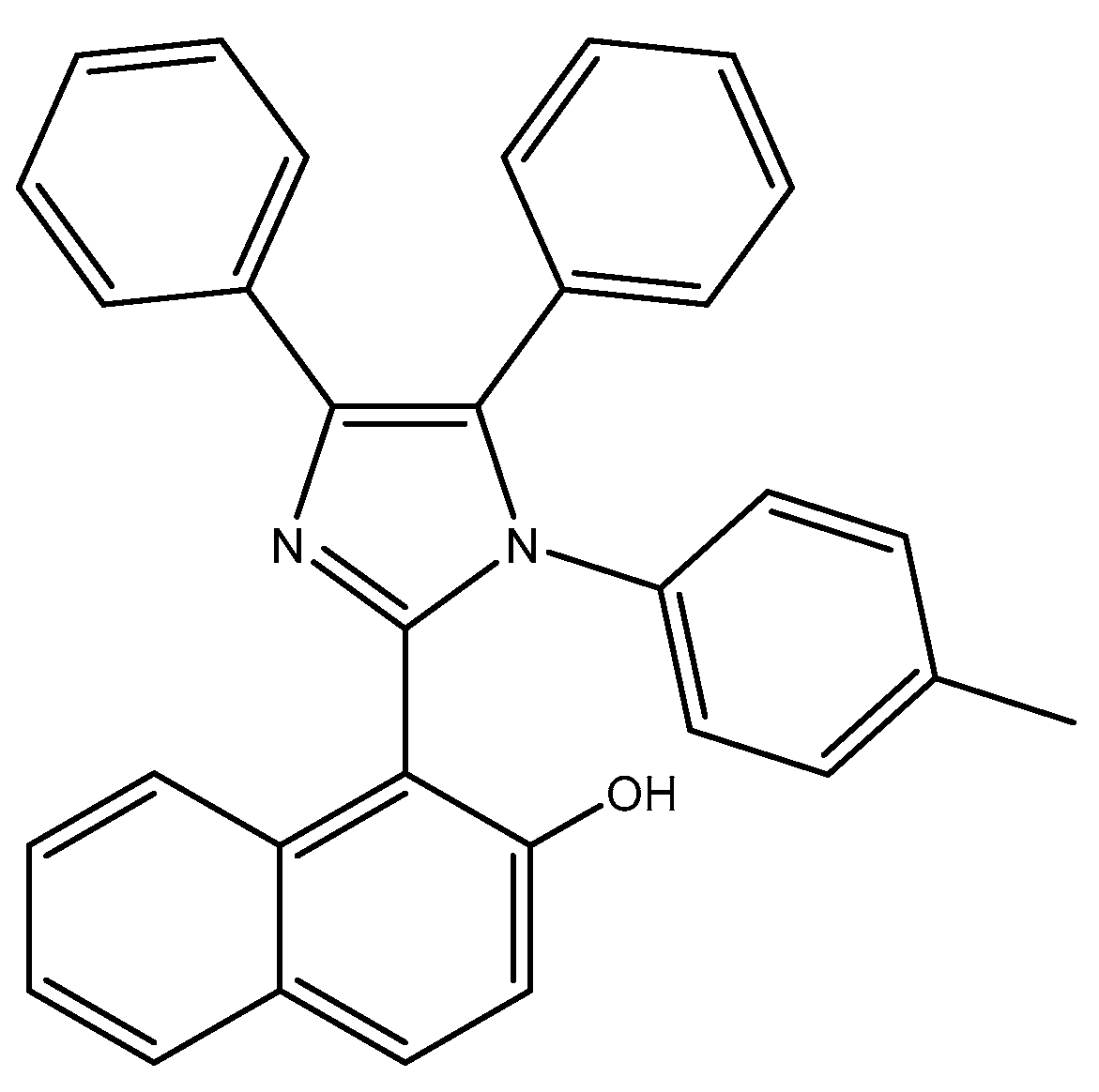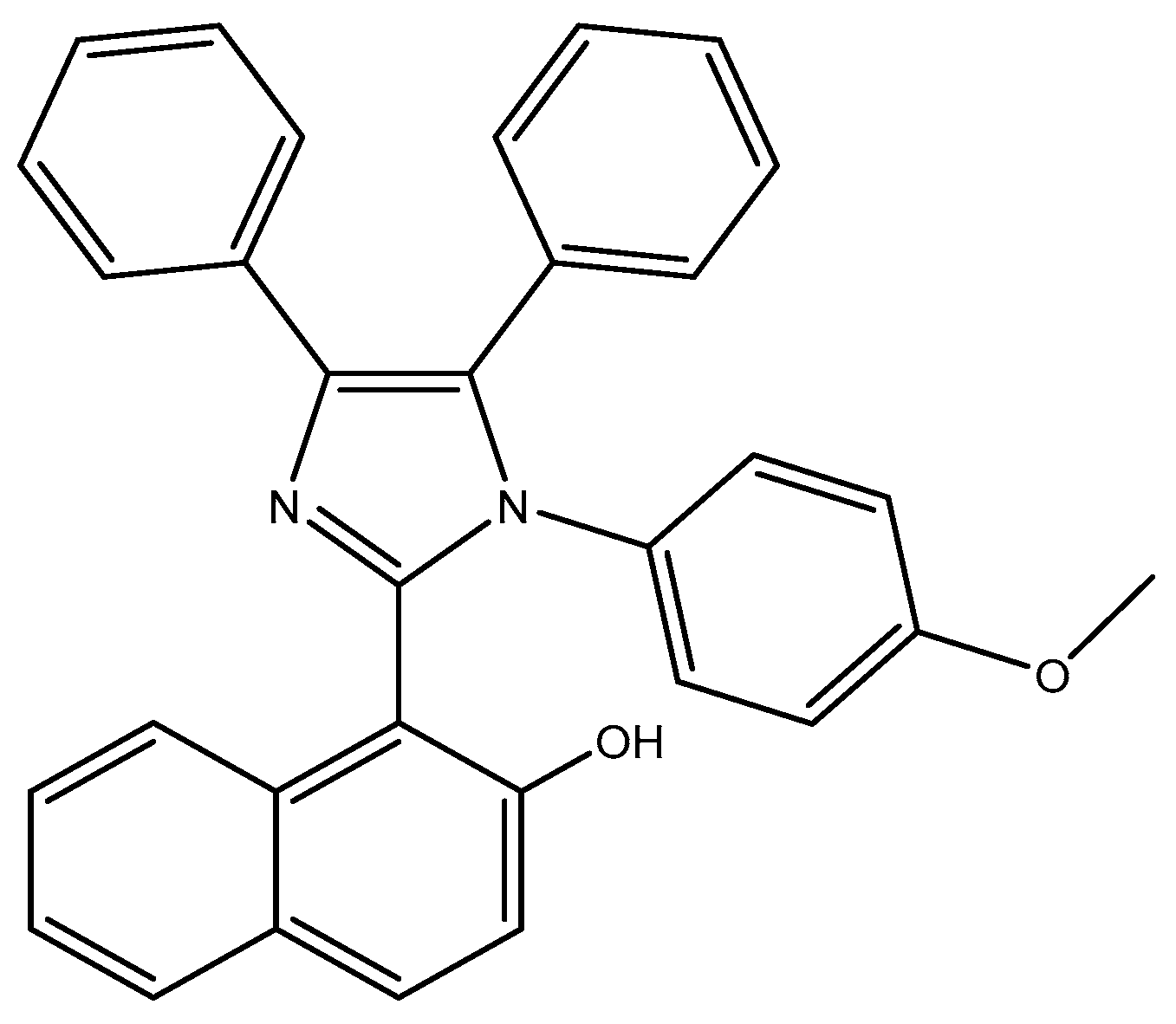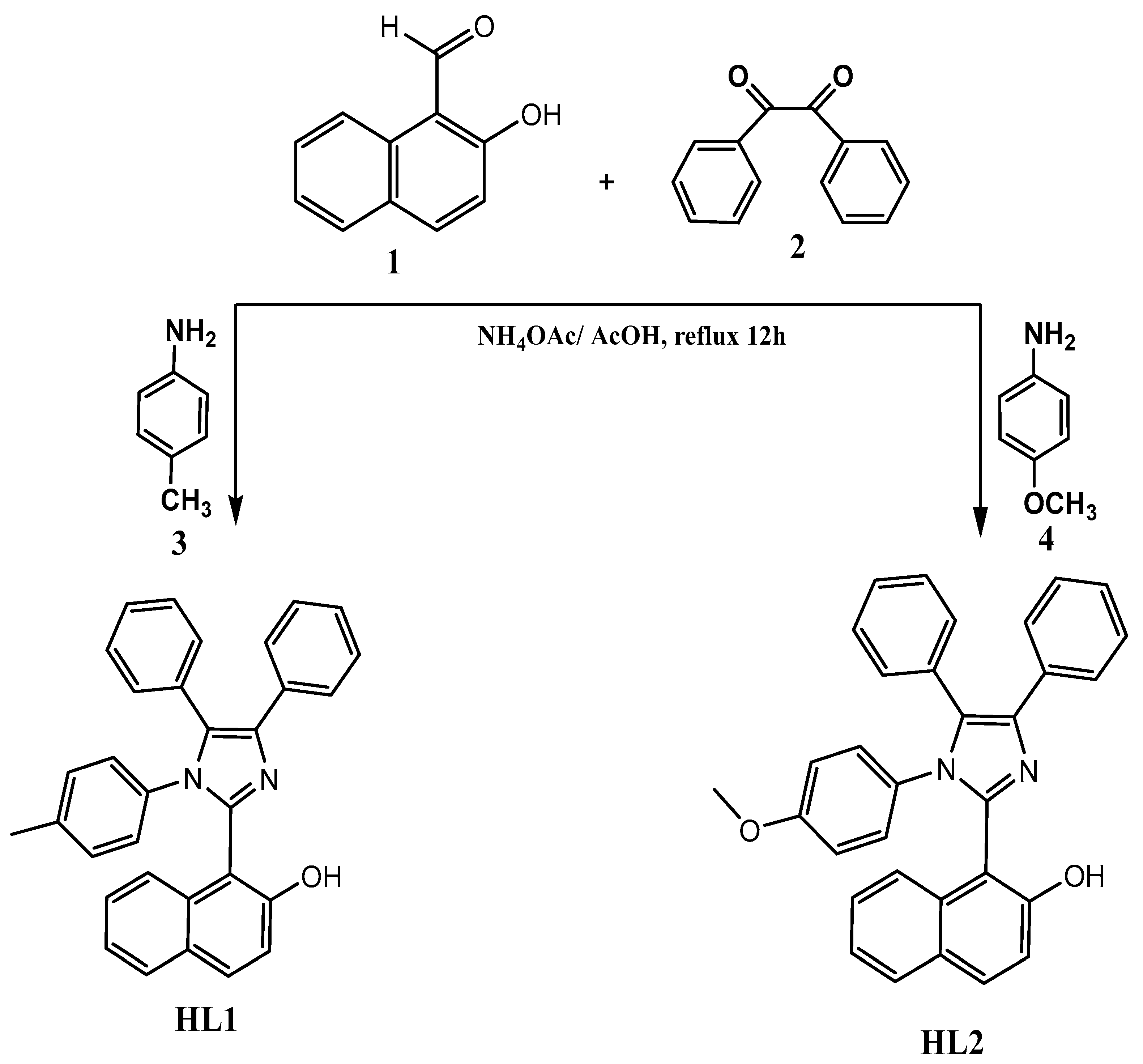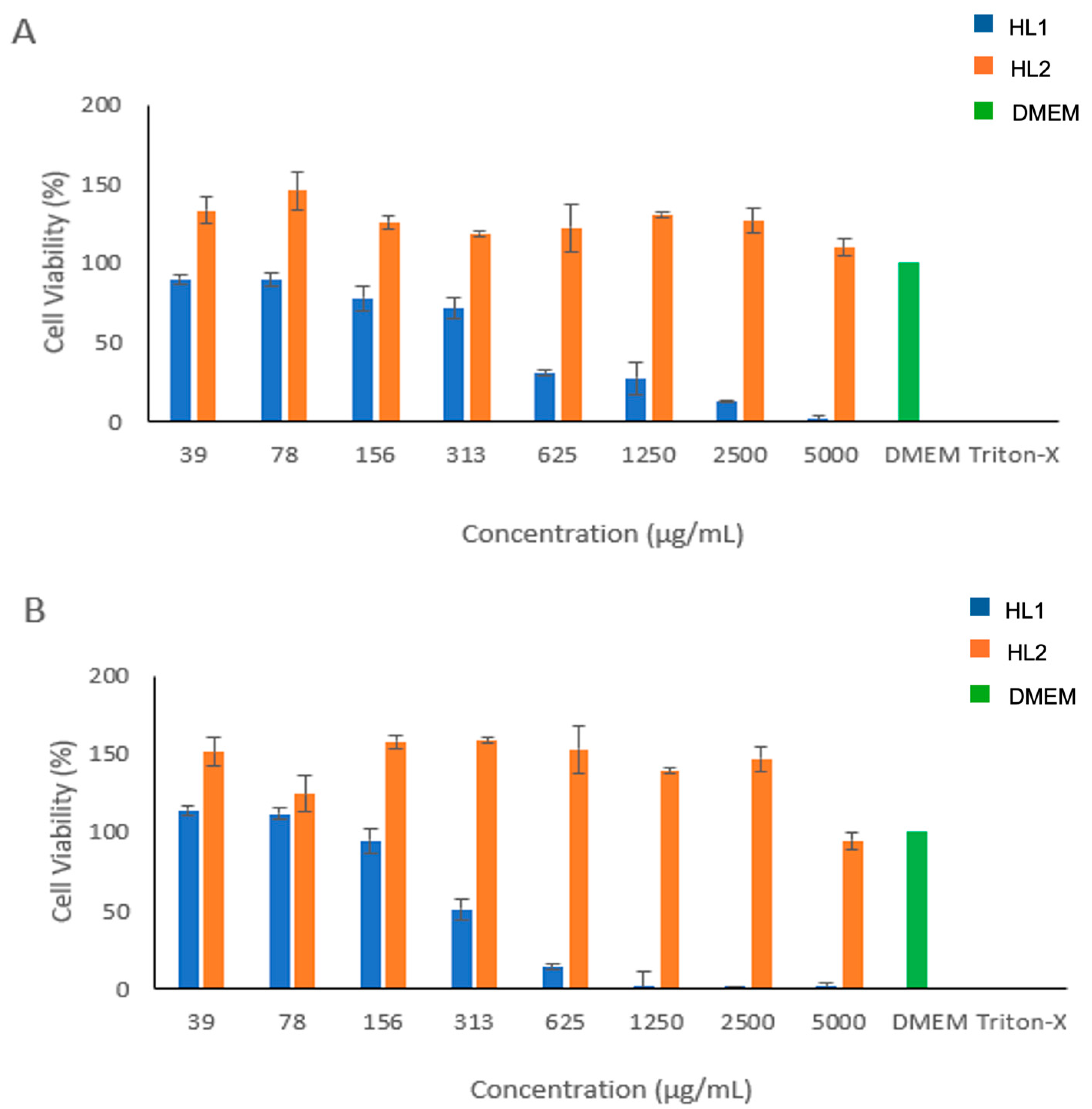Synthesis and Biological Evaluation of Novel Imidazole Derivatives as Antimicrobial Agents
Abstract
:1. Introduction
2. Materials and Methods
2.1. Materials
2.2. Synthetic Procedures of Imidazole Derivatives (HL1 and HL2)
2.3. Nuclear Magnetic Resonance (NMR) Analysis
2.4. Fourier-Transform Infrared Spectroscopy (FTIR) Analysis
2.5. X-ray Diffraction (XRD) Analysis
2.6. Cell Viability Study
2.7. Antibacterial Activity Study
2.8. Statistical Analysis
3. Results and Discussion
3.1. Chemical Profile of Imidazole Derivatives
3.2. Cell Viability Finding
3.3. Antibacterial Activity Finding
4. Conclusions
Supplementary Materials
Author Contributions
Funding
Data Availability Statement
Conflicts of Interest
References
- Kim, H.; Gu, L.; Yeo, H.; Choi, U.; Lee, C.R.; Yu, H.; Koo, S. Rapid Assembly of Pyrrole-Ligated 1,3,4-Oxadiazoles and Excellent Antibacterial Activity of Iodophenol Substituents. Molecules 2023, 28, 3638. [Google Scholar] [CrossRef] [PubMed]
- Tran, T.N.; Henary, M. Synthesis and Applications of Nitrogen-Containing Heterocycles as Antiviral Agents. Molecules 2022, 27, 2700. [Google Scholar] [CrossRef]
- Mermer, A.; Keles, T.; Sirin, Y. Recent studies of nitrogen containing heterocyclic compounds as novel antiviral agents: A review. Bioorganic Chem. 2021, 114, 105076. [Google Scholar] [CrossRef] [PubMed]
- Kerru, N.; Gummidi, L.; Maddila, S.; Gangu, K.K.; Jonnalagadda, S.B. A Review on Recent Advances in Nitrogen-Containing Molecules and Their Biological Applications. Molecules 2020, 25, 1909. [Google Scholar] [CrossRef]
- Alghamdi, S.S.; Suliman, R.S.; Almutairi, K.; Kahtani, K.; Aljatli, D. Imidazole as a Promising Medicinal Scaffold: Current Status and Future Direction. Drug Des. Devel Ther. 2021, 15, 3289–3312. [Google Scholar] [CrossRef]
- Zhang, L.; Peng, X.M.; Damu, G.L.; Geng, R.X.; Zhou, C.H. Comprehensive review in current developments of imidazole-based medicinal chemistry. Med. Res. Rev. 2014, 34, 340–437. [Google Scholar] [CrossRef] [PubMed]
- Anderson, E.B.; Long, T.E. Imidazole- and imidazolium-containing polymers for biology and material science applications. Polymer 2010, 51, 2447–2454. [Google Scholar] [CrossRef]
- Jun, J.; Yang, S.; Lee, J.; Moon, H.; Kim, J.; Jung, H.; Im, D.; Oh, Y.; Jang, M.; Cho, H.; et al. Discovery of novel imidazole chemotypes as isoform-selective JNK3 inhibitors for the treatment of Alzheimer’s disease. Eur. J. Med. Chem. 2023, 245, 114894. [Google Scholar] [CrossRef]
- Huang, W.; Lu, Y.; Yao, N.; Zhang, X.; Wang, N.; Liu, Y. A novel collapse strategy of zeolitic imidazole frameworks shell triggered by p-benzoquinone for the fluorescence monitoring α-glucosidase activity and screening natural anti-diabetes drug. Sens. Actuators B Chem. 2024, 404, 135234. [Google Scholar] [CrossRef]
- Solo, P.; Arockia Doss, M.; Prasanna, D. Designing and docking studies of imidazole-based drugs as potential inhibitors of myeloperoxidase (MPO) mediated inflammation and oxidative stress. Biocatal. Agric. Biotechnol. 2022, 43, 102421. [Google Scholar] [CrossRef]
- Gurav, S.S.; Jadhav, S.R.; Mali, S.N.; Lotlikar, O.A.; Waghmode, K.T. An efficient one-pot multicomponent, Amberlite IR120(H) catalyzed microwave-assisted synthesis of 1,2,4,5-tetrasubstituted-1H-imidazoles: Plausible mechanism and antibacterial evaluation. Synth. Commun. 2023, 53, 2029–2040. [Google Scholar] [CrossRef]
- Raghu, M.S.; Pradeep Kumar, C.B.; Yogesh Kumar, K.; Prashanth, M.K.; Alshahrani, M.Y.; Ahmad, I.; Jain, R. Design, synthesis and molecular docking studies of imidazole and benzimidazole linked ethionamide derivatives as inhibitors of InhA and antituberculosis agents. Bioorganic Med. Chem. Lett. 2022, 60, 128604. [Google Scholar] [CrossRef]
- Ali, I.; Lone, M.N.; Aboul-Enein, H.Y. Imidazoles as potential anticancer agents. MedChemComm 2017, 8, 1742–1773. [Google Scholar] [CrossRef] [PubMed]
- Sharma, P.; LaRosa, C.; Antwi, J.; Govindarajan, R.; Werbovetz, K.A. Imidazoles as Potential Anticancer Agents: An Update on Recent Studies. Molecules 2021, 26, 4213. [Google Scholar] [CrossRef]
- Lee, Y.T.; Tan, Y.J.; Oon, C.E. Benzimidazole and its derivatives as cancer therapeutics: The potential role from traditional to precision medicine. Acta Pharm. Sin. B 2023, 13, 478–497. [Google Scholar] [CrossRef]
- Aliwaini, S.; Awadallah, A.M.; Morjan, R.Y.; Ghunaim, M.; Alqaddi, H.; Abuhamad, A.Y.; Awadallah, E.A.; Abughefra, Y.M. Novel imidazo[1,2-a]pyridine inhibits AKT/mTOR pathway and induces cell cycle arrest and apoptosis in melanoma and cervical cancer cells. Oncol. Lett. 2019, 18, 830–837. [Google Scholar] [CrossRef]
- Wang, Z.; Zhang, Y.; Pinkas, D.M.; Fox, A.E.; Luo, J.; Huang, H.; Cui, S.; Xiang, Q.; Xu, T.; Xun, Q.; et al. Design, Synthesis, and Biological Evaluation of 3-(Imidazo[1,2-a]pyrazin-3-ylethynyl)-4-isopropyl-N-(3-((4-methylpiperazin-1-yl)methyl)-5-(trifluoromethyl)phenyl)benzamide as a Dual Inhibitor of Discoidin Domain Receptors 1 and 2. J. Med. Chem. 2018, 61, 7977–7990. [Google Scholar] [CrossRef] [PubMed]
- Yang, X.; Song, X.; Ray Banerjee, S.; Li, Y.; Byun, Y.; Liu, G.; Bhujwalla, Z.M.; Pomper, M.G.; McMahon, M.T. Developing imidazoles as CEST MRI pH sensors. Contrast Media Mol. Imaging 2016, 11, 304–312. [Google Scholar] [CrossRef]
- Ghannoum, M.A.; Rice, L.B. Antifungal Agents: Mode of Action, Mechanisms of Resistance, and Correlation of These Mechanisms with Bacterial Resistance. Clin. Microbiol. Rev. 1999, 12, 501–517. [Google Scholar] [CrossRef]
- Zhou, J.; Cai, Y.; Liu, Y.; An, H.; Deng, K.; Ashraf, M.A.; Zou, L.; Wang, J. Breaking down the cell wall: Still an attractive antibacterial strategy. Front. Microbiol. 2022, 13, 952633. [Google Scholar] [CrossRef]
- Gujjarappa, R.; Kabi, A.K.; Sravani, S.; Garg, A.; Vodnala, N.; Tyagi, U.; Kaldhi, D.; Velayutham, R.; Singh, V.; Gupta, S.; et al. Overview on Biological Activities of Imidazole Derivatives. In Nanostructured Biomaterials: Basic Structures and Applications; Swain, B.P., Ed.; Springer: Singapore, 2022; pp. 135–227. [Google Scholar]
- Humphries, R.M.; Ambler, J.; Mitchell, S.L.; Castanheira, M.; Dingle, T.; Hindler, J.A.; Koeth, L.; Sei, K. CLSI Methods Development and Standardization Working Group Best Practices for Evaluation of Antimicrobial Susceptibility Tests. J. Clin. Microbiol. 2018, 56, 10–1128. [Google Scholar] [CrossRef] [PubMed]
- Irgashev, R.A.; Kazin, N.A.; Makarova, N.I.; Dorogan, I.V.; Malov, V.V.; Tameev, A.R.; Rusinov, G.L.; Metelitsa, A.V.; Minkin, V.I.; Charushin, V.N. Synthesis and properties of new π-conjugated imidazole/carbazole structures. Dye. Pigment. 2017, 141, 512–520. [Google Scholar] [CrossRef]
- Bathula, C.; Ravindra, M.K.; Kumar, A.; Yadav, H.; Ramesh, S.; Shinde, S.; Shrestha, N.K.; Km, M.; Reddy, V.; Mohammed, A. Microwave assisted synthesis of imidazolyl fluorescent dyes as antimicrobial agents. J. Mater. Res. Technol. 2020, 9, 6900–6908. [Google Scholar] [CrossRef]
- Volkov, M.A.; Novikov, A.P.; Grigoriev, M.S.; Fedoseev, A.M.; German, K.E. Novel Synthesis Methods of New Imidazole-Containing Coordination Compounds Tc(IV, V, VII)—Reaction Mechanism, Xrd and Hirshfeld Surface Analysis. Int. J. Mol. Sci. 2022, 23, 9461. [Google Scholar] [CrossRef]
- Kowalkowska, D.; Dołęga, A.; Nedelko, N.; Hnatejko, Z.; Ponikiewski, Ł.; Matracka, A.; Ślawska-Waniewska, A.; Strągowska, A.; Słowy, K.; Gazda, M.; et al. Structural, spectral and magnetic properties of Ni(ii), Co(ii) and Cd(ii) compounds with imidazole derivatives and silanethiolate ligands. CrystEngComm 2017, 19, 3506–3518. [Google Scholar] [CrossRef]
- Uba, B. Antibacterial and antifungal activities of Schiff base and its metal (Ii) complexes of Fe (Ii), Ni (Ii) and Co (Ii) derived from 2-hydroxy-1-naphthaldehyde and 2-amino-3-methylpyridine. Microbes Infect. Dis. 2023, 4, 312–322. [Google Scholar] [CrossRef]
- Gratal, P.; Arias-Pérez, M.-S.; Gude, L. 1H-imidazo[4,5-f][1,10]phenanthroline carbohydrate conjugates: Synthesis, DNA interactions and cytotoxic activity. Bioorganic Chem. 2022, 125, 105851. [Google Scholar] [CrossRef]
- Balandis, B.; Mickevičius, V.; Petrikaitė, V. Exploration of Benzenesulfonamide-Bearing Imidazole Derivatives Activity in Triple-Negative Breast Cancer and Melanoma 2D and 3D Cell Cultures. Pharmaceuticals 2021, 14, 1158. [Google Scholar] [CrossRef] [PubMed]
- Al-Soud, Y.A.; Al-Ahmad, A.a.H.; Abu-Qatouseh, L.; Shtaiwi, A.; Alhelal, K.A.S.; Al-Suod, H.H.; Alsawakhneh, S.O.; Al-Qawasmeh, R.A. Nitroimidazoles Part 9. Synthesis, molecular docking, and anticancer evaluations of piperazine-tagged imidazole derivatives. Z. Naturforschung B 2021, 76, 293–302. [Google Scholar] [CrossRef]
- Brahmbhatt, H.; Molnar, M.; Pavić, V. Pyrazole nucleus fused tri-substituted imidazole derivatives as antioxidant and antibacterial agents. Karbala Int. J. Mod. Sci. 2018, 4, 200–206. [Google Scholar] [CrossRef]
- Demchenko, S.; Lesyk, R.; Zuegg, J.; Elliott, A.G.; Fedchenkova, Y.; Suvorova, Z.; Demchenko, A. Synthesis, antibacterial and antifungal activity of new 3-biphenyl-3H-Imidazo[1,2-a]azepin-1-ium bromides. Eur. J. Med. Chem. 2020, 201, 112477. [Google Scholar] [CrossRef] [PubMed]
- Atia, A.J.K. Synthesis and Antibacterial Activities of New Metronidazole and Imidazole Derivatives. Molecules 2009, 14, 2431–2446. [Google Scholar] [CrossRef] [PubMed]
- Sawyer, P.R.; Brogden, R.N.; Pinder, K.M.; Speight, T.M.; Avery, G.S. Clotrimazole: A Review of its Antifungal Activity and Therapeutic Efficacy. Drugs 1975, 9, 424–447. [Google Scholar] [CrossRef] [PubMed]




| Bacterial Strains | Imidazole Derivatives | Vancomycin | Ciprofloxacin | |
|---|---|---|---|---|
| HL1 | HL2 | |||
| (μg/mL) | (μg/mL) | (μg/mL) | (μg/mL) | |
| Staphylococcus aureus (ATCC 29213) | 625 ± 0.04 | 625 ± 0.02 | 0.63 ± 0.00 | 0.16 ± 0.00 |
| Staphylococcus aureus (MRSA; ATCC 43300) | 1250 ± 0.02 | 625 ± 0.04 | 0.31 ± 0.00 | 0.16 ± 0.04 |
| Escherichia coli (ATCC 25922) | >5000 | 2500 ± 0.03 | 10 ± 0.01 | 0.02 ± 0.00 |
| Acinetobacter baumannii (ATCC 747) | 1250 ± 0.10 | 2500 ± 0.05 | >40 | 0.16 ± 0.00 |
| Pseudomonas aeruginosa (ATCC 1744) | 5000 ± 0.04 | 2500 ± 0.04 | >40 | 0.63 ± 0.10 |
Disclaimer/Publisher’s Note: The statements, opinions and data contained in all publications are solely those of the individual author(s) and contributor(s) and not of MDPI and/or the editor(s). MDPI and/or the editor(s) disclaim responsibility for any injury to people or property resulting from any ideas, methods, instructions or products referred to in the content. |
© 2024 by the authors. Licensee MDPI, Basel, Switzerland. This article is an open access article distributed under the terms and conditions of the Creative Commons Attribution (CC BY) license (https://creativecommons.org/licenses/by/4.0/).
Share and Cite
Al-Ghamdi, H.A.; Almughem, F.A.; Alshabibi, M.A.; Bakr, A.A.; Alshehri, A.A.; Aodah, A.H.; Al Zahrani, N.A.; Tawfik, E.A.; Damiati, L.A. Synthesis and Biological Evaluation of Novel Imidazole Derivatives as Antimicrobial Agents. Biomolecules 2024, 14, 1198. https://doi.org/10.3390/biom14091198
Al-Ghamdi HA, Almughem FA, Alshabibi MA, Bakr AA, Alshehri AA, Aodah AH, Al Zahrani NA, Tawfik EA, Damiati LA. Synthesis and Biological Evaluation of Novel Imidazole Derivatives as Antimicrobial Agents. Biomolecules. 2024; 14(9):1198. https://doi.org/10.3390/biom14091198
Chicago/Turabian StyleAl-Ghamdi, Huda A., Fahad A. Almughem, Manal A. Alshabibi, Abrar A. Bakr, Abdullah A. Alshehri, Alhassan H. Aodah, Nourah A. Al Zahrani, Essam A. Tawfik, and Laila A. Damiati. 2024. "Synthesis and Biological Evaluation of Novel Imidazole Derivatives as Antimicrobial Agents" Biomolecules 14, no. 9: 1198. https://doi.org/10.3390/biom14091198
APA StyleAl-Ghamdi, H. A., Almughem, F. A., Alshabibi, M. A., Bakr, A. A., Alshehri, A. A., Aodah, A. H., Al Zahrani, N. A., Tawfik, E. A., & Damiati, L. A. (2024). Synthesis and Biological Evaluation of Novel Imidazole Derivatives as Antimicrobial Agents. Biomolecules, 14(9), 1198. https://doi.org/10.3390/biom14091198






